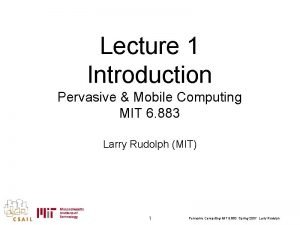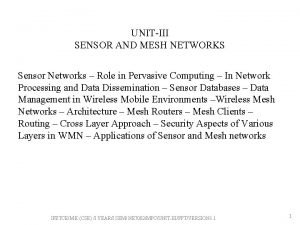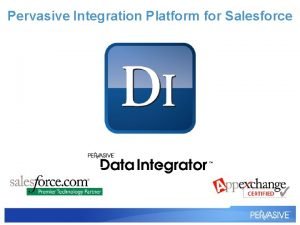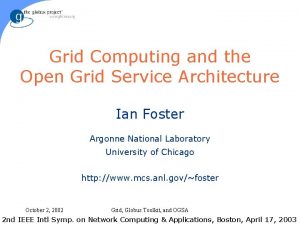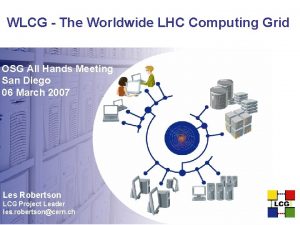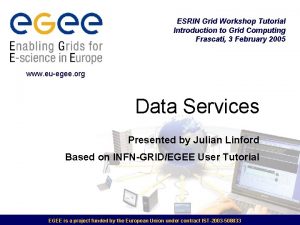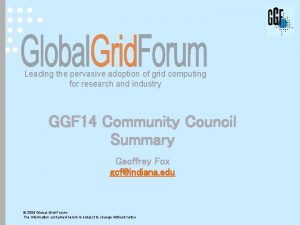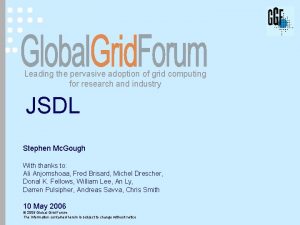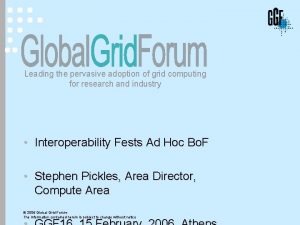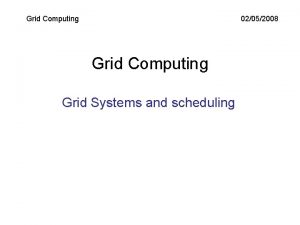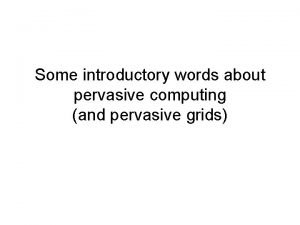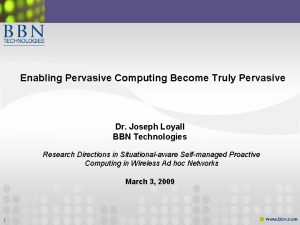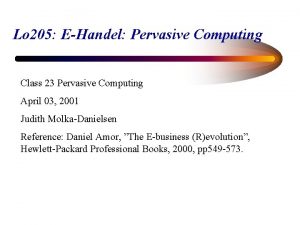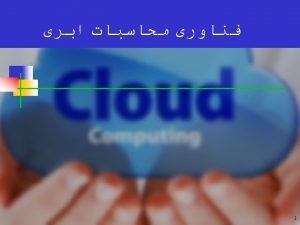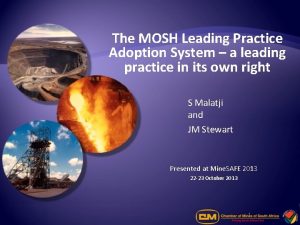Leading the pervasive adoption of grid computing for




























- Slides: 28

Leading the pervasive adoption of grid computing for research and industry • GGF 14 – OGSA MWS BOF • WS-Management • • John Tollefsrud Sun Microsystems © 2005 Global Grid Forum The information contained herein is subject to change without notice

Agenda • • Motivation WS-Management introduction Wiseman open source project Announced supplier support

Trends in systems management • Distributed environments more common. – Crossing companies, geographies, platforms. • Building a common substrate for IT with Web services. – Web services used for: • • • Device discovery and eventing. Single sign on and identity management. Enterprise application integration. Mobile. … • Lifecycle support costs growing, eating up more IT budget. – Over $15 Billion in 2004? – 80% of IT budgets go to running the business, not innovation* Source: “IT Spending, How Do You Stack Up? ”, Gartner, Jan. 2004

Challenges in systems management • Consistent management of systems resources • Consistent reporting of system failures • OS awareness of the hardware state • Monitoring DMZ servers and applications • Net result – high TCO

Addressing the problem Create standard scaleable management protocol Distributed service Systems on one computer CPU, NIC… Scale Up & Down in Software/Firmware • Data model neutral • Composable protocol stack Scale Up & Down on Hardware Devices Clients Servers CORE REQUIREMENTS • Build to support all sizes of device and application • Work in all pre- and post-boot operational environments • Provide consistent access across multiple management models • Enable management across multiple administrative domains • Support access to traditional- & SOA-based applications equally • Make it secure, on all devices • Tightly align with WS-* arch. • Aim for future-proof

What is WS-Management? • WS-Management defines a SOAP-based protocol for Systems Management WS-Management • Is a profile – a collection of references to First Published: other composable specs – WS-Addressing, WS-Eventing, WS-Transfer and WSEnumeration • Specifies extensions to and restricts how these protocols can be used • Designed to scale down to small-devices • Defined over existing standards – HTTP/S, TCP/IP, TLS, XML, URI, SOAP • Designed to be Model-agnostic – compatible with the CIM Object Model Oct 2004 Authors: AMD BMC Dell Intel Microsoft Sun WBEM Solutions

WS-Management targets typical management operations • Typical systems management operations – Get, Put and Delete properties of managed resources – Create references to manageable resources – Enumerate the contents of containers and collections such as large tables and logs – Subscribe to events emitted by managed resources – Execute specific management methods – (Resource Discovery is out of scope in the current version of the spec) • Operations are optional in WS-Management and implementations are free to add more

WS-Management Transfer functions • Defined by WS-Transfer – – Get Put Create Delete • Defined by WS-Mgmt – Partial Get – Partial Put – Rename

Enumerating data sources • Same as WS-Enumeration specification • WS-Management allows using partial results Enumerate ponse Enumerate. Res (Context) Pull(3) Pull. Response Pull(4) Pull. Response Release. Respo Client Agent Item Collection

WS-Management Eventing functions • Defined by WS-Eventing • Defined by WS-Management – Subscribe – Push. With. Ack – Batched – Pull Deliver Management Console Get Subscribe Group Policy Server

Heartbeats • Pseudo-events as part of subscription monitoring • Instruction included in wse: Subscribe

Bookmarks • Optional capability for Log-backed subscriptions • Bookmark is included with each event delivery – Service-defined cursor in the event stream – Opaque to the client • Allows a later restart where the subscription left off

Security Profiles • Request-reply – wsman: secprofile/https/standard – wsman: secprofile/https/mutual • Events – wsman: secprofile/https/standard/user. Ref – wsman: secprofile/https/mutual/certhash • Not an exhaustive list, more profiles could be supported

WS-Management Catalog • Lists the available Resource. URIs • Provides searchable metadata (Keywords) • Provides relationships to external and internal resources (eg Web URLs) • Describes supported actions for each resource • Can provide the complete WSDL for a resource using WS-Transfer: Get • Can provide the XML Schema for a resource using WS-Transfer: Get

Implementation • The wiseman project

The wiseman project • https: //wiseman. dev. java. net • An open source project by Sun Microsystems • Apache License 2. 0 • Prototype code – not yet product-quality – Developed outside of formal processes – Architecture, APIs can change • Proven interoperability • Initial Implementation is for Java SE 5+

Wiseman project base technologies • Java SE 5+ – Base platform • org. w 3 c. dom – Document, Element, Node, Attributes • SOAP with Attachments API for Java (SAAJ) 1. 3 – Message, Envelope, Body, Header, Fault • Java Architecture for XML Binding (JAXB) 2. 0 – XML ↔ Java (based on Schema)

Wiseman handler architecture

Wiseman project to-do’s • WS-Management – Fragment-level WS-Transfer – Eventing extensions – Many Faults • CIM Mapping • WS-Managment Catalog • A Simple API for the casual developer • Documentation – Java. Doc, FAQ, Developer Guide

Delivering WS-Management Suppliers have announced WS-Management product plans

Sun Microsystems product support for WS-Management • Sun announced product support plans: – x 64 servers / service processors in 2006 – Solaris – N 1 Preso source: Microsoft Win. HEC 2005

Microsoft Windows Server 2003 “R 2” (2005) • Supported features – WS-management stack (server and client) – Supports HTTPS – in-band OOB – IPMI kernel driver (supports version 1. 5 or higher) – IPMI provider – subset of CIM IPMI profile – Support for X 86, IA 64, AMD 32/64 – Report SEL events to NT event log – Report BSOD and shutdown to BMC SEL – Remote subscriptions to SEL events OOB (over HTTPS) – Scripting client API (OLE Automation) • Limitations – Only subset of classes in IPMI CIM profile supported – Only supports management controllers with KCS interface – Only supports https – No remote discovery of WMI instrumentation Preso source: Microsoft Win. HEC 2005

WS-Management & Microsoft Operations Manager • Windows Server 2003 “R 2” – Existing MOM agent can integrate using WS-man scripting interface – Management Packs can be modified to support IPMI • Windows Longhorn and MOM V 3 – Use of WS-Management for agentless monitoring across firewall – Use of WS-Management for OOB access – Down-level support is planned (Windows Server 2003 SP 1 or newer releases) • Support out-of-band access for existing BMC – Not included in Windows – Delivery vehicle TBD Preso source: Microsoft Win. HEC 2005

Windows Longhorn Update (planning in process) • Forwarding OS events – Client side monitoring – Forwarding from DMZ servers • TCP transport – SOAP framing protocol – Integrated security for Windows to Windows scenarios • New administration tools in the box – Instrumentation viewer – New Event Viewer • Additional h/w management capabilities – Set of additional IPMI profiles for richer h/w management experience • Full access to and discovery of WMI instrumentation – CIM to XML mapping – Mapping WMI namespaces to Catalog Preso source: Microsoft Win. HEC 2005

Intel® AMT Intel AMT Mgmt Apps & Other consumers • Host platform managed through the external interface • Intel® AMT accesses sensor and effectors • Intel® AMT accesses Host OS and Applications Network Platform Managed Node Mgmt Agent Application Intel® AMT WS-Man OS SEI Capability Providers Modules BIOS Execution Environment HW FW Intel® AMT Hardware WS-MAN for both IB & OOB Preso source: Microsoft Win. HEC 2005


To Summarize. . • based on the Web Service infrastructure, which means – Platform Independence – Same toolset for applications and systems management • a common management protocol for the entire stack – – Hardware Operating System Applications Services

For more information – https: //wiseman. dev. java. net – http: //msdn. microsoft. com/webservices – http: //java. sun. com/webservices
 Mobile computer wikipedia
Mobile computer wikipedia Pervasive and mobile computing
Pervasive and mobile computing Pervasive and mobile computing
Pervasive and mobile computing Pervasive computing ppt
Pervasive computing ppt Techy tipe now
Techy tipe now Bobbin leading principle
Bobbin leading principle Salesforce company overview
Salesforce company overview Melancholic features
Melancholic features Specific and pervasive boundaries for behavior
Specific and pervasive boundaries for behavior Pddst
Pddst X-trace: a pervasive network tracing framework
X-trace: a pervasive network tracing framework Pervasive developmental disorder
Pervasive developmental disorder Lga vs pga socket
Lga vs pga socket Globus grid computing
Globus grid computing Grid computing ejemplos
Grid computing ejemplos Ogsa in grid computing
Ogsa in grid computing Worldwide lhc computing grid
Worldwide lhc computing grid Grid computing introduction
Grid computing introduction Introduction to grid computing
Introduction to grid computing Challenges of grid computing
Challenges of grid computing Challenges of grid computing
Challenges of grid computing Sas grid computing
Sas grid computing Grid computing introduction
Grid computing introduction Grid and cloud computing definition
Grid and cloud computing definition Derivatives of grid computing
Derivatives of grid computing Grid computing tutorial
Grid computing tutorial Grid computing security
Grid computing security Sas grid computing
Sas grid computing Grid computing infrastructure
Grid computing infrastructure

